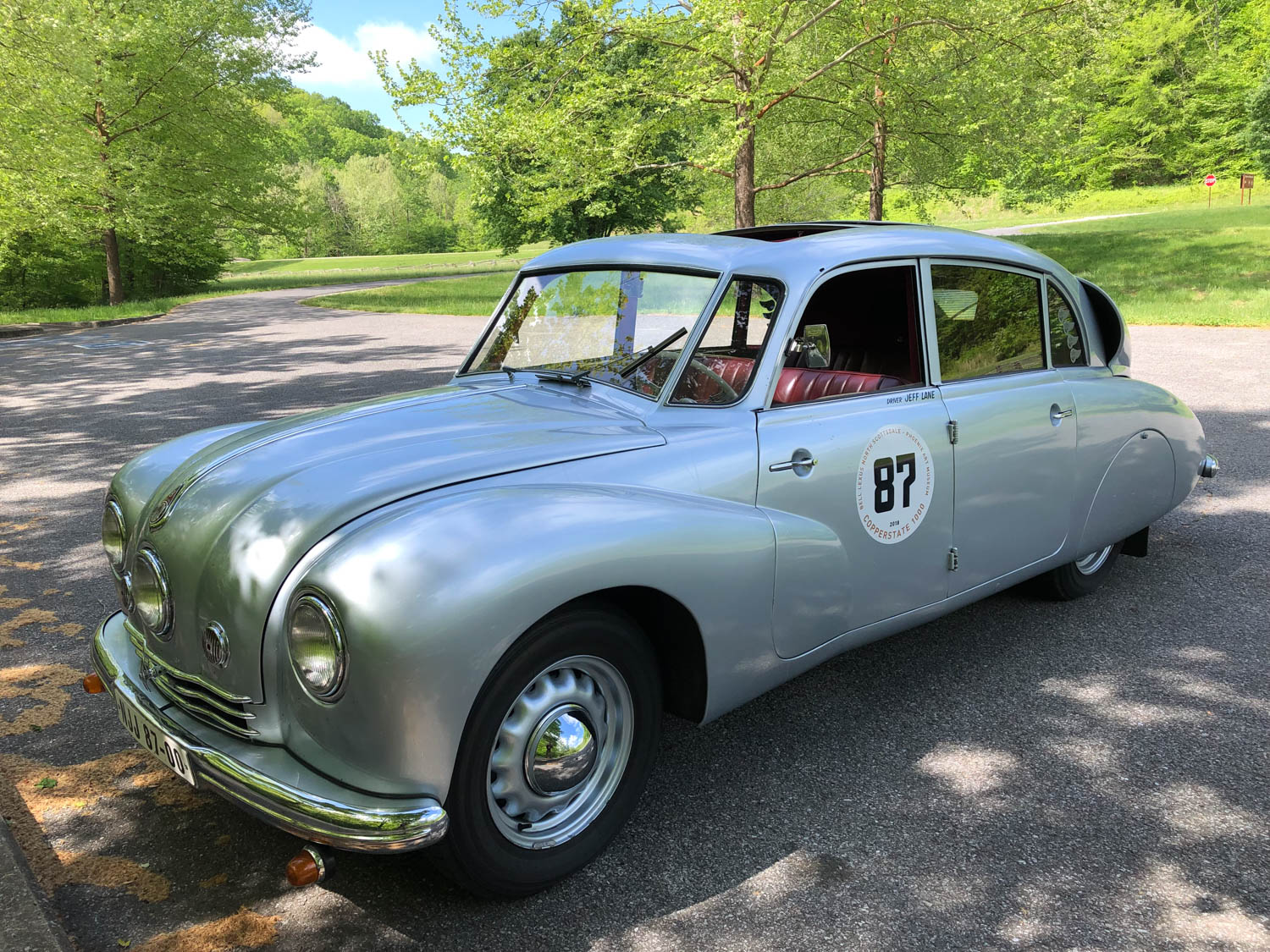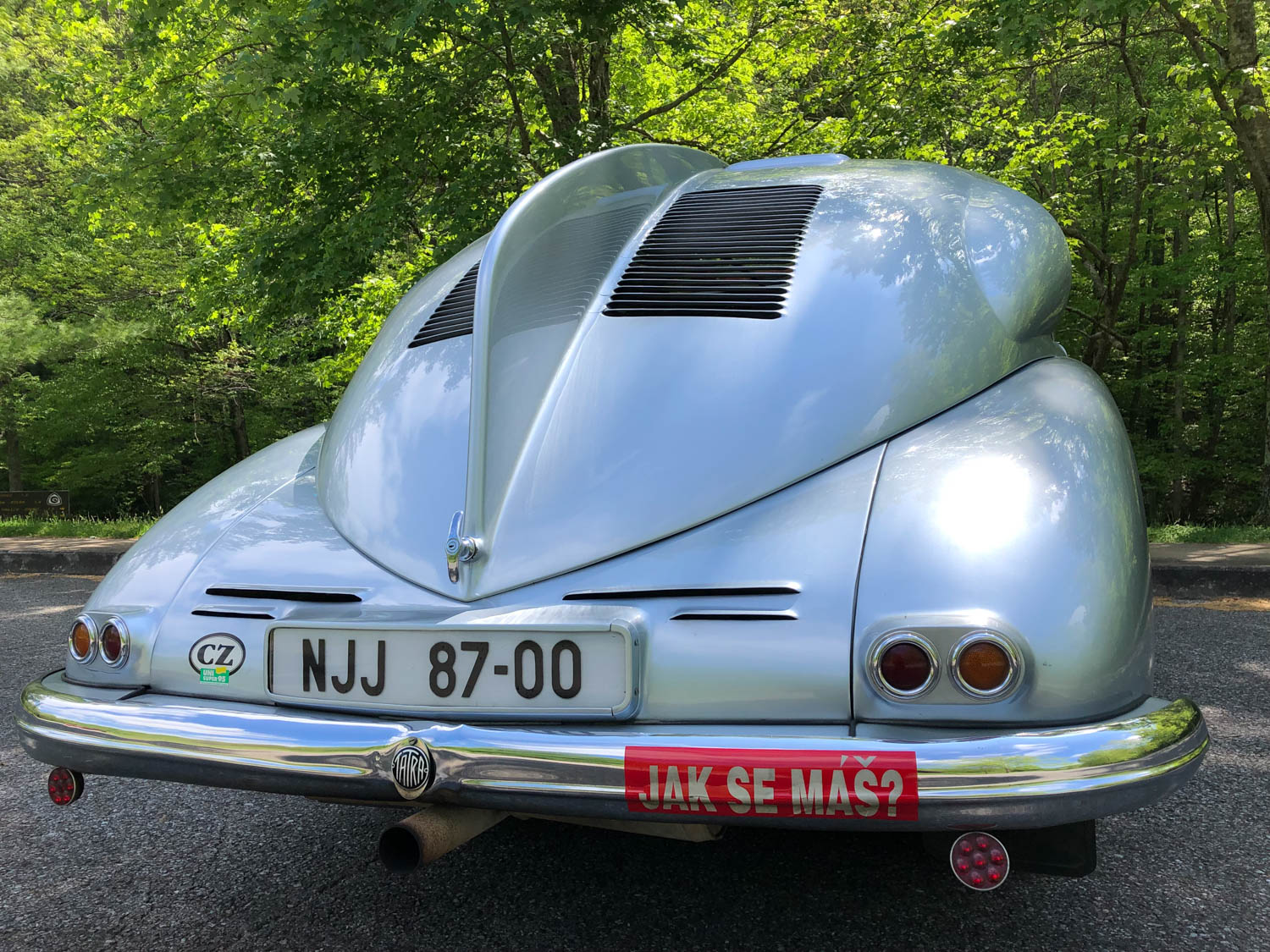Media | Articles
Holy crap, I got to drive a Tatra T-87
I’m fortunate that with my job at Hagerty, I get to drive a lot of interesting cars. I’ve always wanted to drive a Tatra and recently got the chance. OK, so what’s the big deal? Styling wise, you can tell right away that the Tatra is something different, and the mechanicals are just as interesting. It has a rear-mounted, air-cooled V-8. How cool is that? Built in Czechoslovakia, these cars were pretty aerodynamically advanced, and had some distinct touches you’d never forget. Tatra only made about 3,000 of these from 1936 to 1950, and none were sold in the United States, so it is indeed a rare piece.
The 1947 Tatra T-87 I drove, which is part of the eclectic collection at the Lane Motor Museum, is very road worthy, having participated in museum rallies, the Great Race, and the Copperstate 1000 last year. My time behind the wheel covered a couple of hundred miles of motoring on one of my favorite roads in the country, the Natchez Trace Parkway. Winding through the hills between Nashville, Tennessee, and Tupelo, Mississippi, it’s a scenic road with smooth curves and plenty of places to stop and smell the flowers.

Starting at the front, you notice a bulbous front end with three headlights for improved nighttime visibility. It reminds me of a locomotive and is a little like a Tucker in that respect, although the Tatra’s center light doesn’t move with the front wheels. Sweeping back to the windshield, the Czechs didn’t have the ability to create curved glass for the car, so three pieces of flat glass make up the relatively panoramic windshield. It works nicely with the design and gives it a likeness to the cockpit of a World War II bomber. The roofline sweeps back to the tail, and take a look at that incredible sunroof! The weather on my drive was perfect, and I had the roof open to take in all the splendor that nature offered.
Marketplace
Buy and sell classics with confidence

Moving around to the side, you can really take in more of the aerodynamic features of the design. Rear wheel spats, that magnificent dorsal fin, smooth curves all the way to the rear bumper. Notice the two ears just as you pass the rear quarter windows. Those are air intakes, which should tell you that something special is going on with the engine. Four doors open to a spacious and comfortable place to take a drive or a ride.

The rear of the car offers my favorite view. Cooling vents abound for the rear-mounted V-8, displacing a little under 3.0 liters. It is air cooled, produces about 75 horsepower, and even has overhead cams. Thanks to the aerodynamics of the car, that’s good enough to push the Tatra T-87 to 100 mph, or a little over 160 km/h, as indicated on the speedometer. And check out that single bazooka exhaust.

Climbing inside the car, you are really struck by how opulent it is. Trimmed in red felt and soft vinyl, it’s my favorite color combination against silver paint. It’s a little Art Deco in there, which I love. Travel left to right across the instrument panel and you’ll find the fuel level, oil temperature, speedometer, and a clock at the far side. There is an Autometer oil pressure gauge where the ashtray used to be, and that’s a worthy addition to any classic. To start the car, there’s a little switch under the dash you click to the right, then hit the starter button at the far left. With a mechanical clang from the starter, the V-8 roared to life and settled down to a nice idle.

Down in the footwell of the car is a pretty standard setup for a manual-transmission car of this era. The floor-mounted shifter controls four forward gears plus reverse, and there are synchronizers on only third and fourth gear. What’s that additional control in the middle of the floor? It’s the central lubrication actuator. If you use your foot to push that spring-loaded peg down, it shoots oil into the suspension components.
Alright, time to move. I was following a pack of other classics, including a 1963 Fiat Multipla, 1971 Lotus Europa, and some other fun cars in our group. I’m pretty familiar with the double clutching on older non-synchronized transmissions, so I was expecting a truck-like experience in the Tatra. I was really surprised how smooth it all was; engaging first gear by going to second beforehand reduced the grind to almost nil, and the clutch was easy to modulate.
A little blip of the throttle and I was off and running. While there’s no tachometer, the speedo has handy hash marks on it to show the driver a maximum recommended speed in each gear. That’s a help, but not knowing if the speedometer was accurate meant I just felt for the right moment to shift up. Working through the gearbox was easy. A little blip for a smooth shift to second was all it needed, then third and up to top without any fuss at all. The speed limit on the Parkway is 50 mph, so I cruised at about 80–85 km/h and listened to the engine note and those big cooling fans doing their thing behind me.

There are some pretty good hills to climb on the Parkway, and I was curious how much shifting would be needed to maintain speed. I only needed to go back down to third occasionally, and probably could have kept it in top gear if it wasn’t for the less-powerful Fiat ahead of me. I realize 75 horsepower doesn’t sound like a lot, but it moves the Tatra along just fine. This car won’t rip your eyes out on acceleration, but you want to be easy on those gears anyway. The T-87 also has manual brakes that require a very firm application of the pedal, so I think keeping the speed in check is a good idea regardless.
There’s a little bit of a waggle to contend with as you navigate the corners. With a soft suspension and all that weight in the rear, momentum and inertia factor into any hustling in the bends. If you can imagine driving a Porsche 911 with a refrigerator strapped to the roof, you get the general idea of what’s happening here.
If there is any downside to the T-87 driving experience, it has to be in the realm of rearward visibility. I’m not sure why Tatra bothered to put any mirrors on the car at all. From the driver’s seat, the narrow and vertical outside mirrors give you a great view of the inside of the air intakes for the engine and not much else. The inside rear-view mirror is fairly useless, as well, showing you the world through two small panes of glass out the rear, split in half by the dorsal fin. In all seriousness, there was a 50 mph stretch where the Lotus was a few car lengths behind me, and I had no idea it was there.

Driving the Tatra T-87 was a weird, wonderful time with a unique piece of automotive history. I’m always thankful for friends who like to share their old cars, and it’s a reminder that the more we get out and experience the motor world, the better we are for it. See you down the road!










